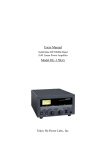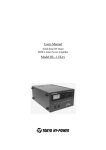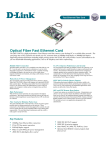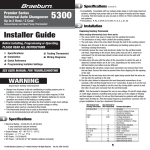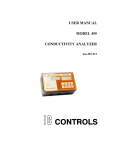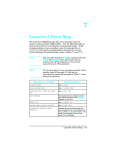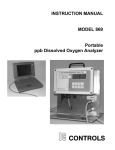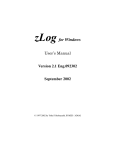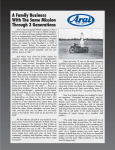Download Users Manual Model HL-550FX
Transcript
Users Manual Solid-State HF/50MHz Band 550W Linear Power Amplifier Model HL-550FX 1. Introduction Thank you for purchasing the HL-550FX. This compact and lightweight desktop HF linear power amplifier has a maximum input power of 1.2kW. Our solid-state broadband power amp technology makes it the smallest and lightest in the industry in its class. Typical output power is 550W (SSB, CW) with the drive power of 65-90W. It is best suited for the DX-pedition use due to its light and compact design. 2. 2-1 Cautions The amplifier is cooled by forced airflow. Several inches of clearance on the top and the rear wall are necessary to allow for smooth air intake into the fan. Do not block the air vents on the top cover. 2-2 Keep the amplifier out of direct sunlight, in a cool dry environment. 2-3 Internal high voltages (AC, DC and RF), are present at all times, ON AIR or OFF. Internal access should be limited to avoid injury. 2-4 Turn off the AC main power immediately upon any unusual sounds, sights, or odors. Check the multimeter readings of Vd and Id, the fuses and all cable connections around the amplifier. Please notify the dealer or the factory of any problems. 2-5 For your safety, do not operate the amplifier without adequate grounding. A proper ground connection will result in peak performance and stability, in addition to reduced RF strays or noises. 2-6 To eliminate the RF interference to such home appliances as TV, FM radio, telephone sets, and etc., it is recommended that clamp-on ferrite cores be inserted at both ends of the remote control cable, ALC cable, coaxial jumper cable, and antenna cables, as needed. Also, a common mode AC line filter (near the AC outlet), and in-line low pass filters on the antenna coaxial cable (as necessary), are recommended. 1 2-7 The amplifier has fast acting sophisticated protection circuits. Please note, however, any such actions that cause the same fault to occur repeatedly, will lead to failure of the valuable final power FET transistors. 2-8 Before checking inside the amplifier, be sure to wait a few minutes for the high DC voltage to discharge (monitor Vd meter reading). The potentiometers for RF power detector, protection circuits, FET bias voltage circuit, etc., are precisely adjusted at the factory, and should not be altered. Doing so, would require readjustment with precision measuring instruments. 2-9 The DC power supply section consists of most efficient and sophisticated switching mode circuit. It accepts the wide AC line voltages ranging from AC 100V up to 260V. Since the line voltage is detected and selected automatically, you do not have to worry about the tap change of internal power transformer whichever country you will travel. Be sure to verify capacity of AC line fuse before you plug the AC power cord into the outlet. 2-10 Before starting the amplifier, be sure to connect a dummy load (50 ohms, 550W min.) or a well-adjusted antenna to the output terminal. Operating without any load will cause extreme stress to the RF power FET’s, although protection circuits should work under critical conditions. 2-11 Required drive power is slightly less than 100W to obtain the full 550W output. Do not attempt to operate with excessive drive from a high power transceiver. 2-12 Keep the aluminum heat sink and air openings free from dust and blockages. Periodic cleaning will prevent degraded cooling efficiency. 2-13 For long continuous operation in RTTY/FM modes, it is recommended that you reduce the RF drive levels by 20% to 30% lower output than CW/SSB modes. 2-14 To prevent damage to the precision electronic components, avoid extreme physical shock to the amplifier. If factory service is required, the amplifier should be shipped using the original box and packing materials. 2 3. 3-1 Features Our solid-state broadband design engineers worked to make the HL-550FX, the lightest and most compact 550W out portable HF/50MHz amplifier in the industry. This world-class compact 550W HF amplifier is the easiest to handle and operate anywhere in the world. 3-2 The amplifier’s main PA section includes 4 high power MOS FET VRF150, resulting in 550W (SSB/CW max.) on HF and 500W on 50MHz bands. The amplifier’s broadband characteristics require no further tuning once the operating band is selected. 3-3 The amplifier allows operation in full break-in CW mode due to the use of the amplifier’s high-speed antenna relays (made by Panasonic). 3-4 With the unique duct structure design and the powerful blower fan, the aluminum heat sink block for RF PA module (and other components), are effectively cooled. The fan’s quiet operation allows for even the weakest DX signals to be heard. 3-5 The amp utilizes a sophisticated circuit to run the various high speed protection circuits such as overdrive, high antenna SWR, DC overvoltage, band miss-set etc. 3-6 This amplifier is compatible with wide AC line voltage ranging from AC 100V to 260V. Although AC line voltage is automatically selected, be sure to install proper fuse into AC line fuse holder. 3-7 For the safety of the operator, an Interlock system is employed. The AC power is shut down if the top cover is removed, and the automated safety interlock is activated. 3-8 An analog multimeter allows the operator to monitor Pf (Forward output power), Pr (Reflected power), Vd (Drain voltage of power FET), Id (Drain current) etc. 3 4. Specifications Frequency Band 1.8~50 MHz all amateur bands including WARC bands Mode SSB, CW (RTTY) RF Drive 65~90W typ. (100W max.) Output Power HF: 550W typ., 50MHz: 500W (RTTY, SSTV, FM 250W max.) (When set to AC100V-120V, 500W on both HF and 50MHz) Drain Voltage 44V Drain Current 30A max. Input Impedance 50Ω (unbalanced) Output Impedance 50Ω (unbalanced) Final Transistor VRF150 x 4 Circuit Class AB parallel push-pull Cooling Method Forced Air Cooling Multi-meter (F.S.) Output Power Pf 1kW Reflected Power Pr 100W Drain Voltage Vd 60V Drain Current Id 50A Input/Output Connectors UHF SO-239 (Type M-J) AC Power AC 200~260V, 50/60Hz 7.5A max. AC 100~130V, 50/60Hz 15A max. AC Consumption 1.3kVA max. when TX Dimension 232 x 145 x 392 mm, 9.1 x 5.7 x 15.4 inches (WxHxD) Weight Approx. 9.2kgs. or 20.9lbs. Accessories AC Power Cord x 1 Coax Jumper Cable (with PL259 at both ends) x 1 RCA Plug x 2 Spare Fuse 8A x 2 (for AC200V line) Spare Fuse 15A x 2 (for AC100V line) Spare Fuse 15A x 2 (for F202, F203 of PC1662V power amp board) Spare Fuse 1A x 1 (for PC1662V power amp board) (miniature fuse) Spare Fuse 3.2A x 1 (for PC1819 sub AC control board) (miniature fuse) Users Manual 4 5. 5-1 AC Line Voltage Although the amplifier is designed to work with both AC 115V (100-130V) and AC 230V (200-260V), for stability we recommend operation from AC 230V. 5-2 The correct AC plug (not included in the package) must be obtained locally due to the AC plug variations worldwide. 5-3 The AC line fuse has been factory preset for 115V use (or as requested by the customer at the time of order). If you wish to change to AC 230V, change the fuse to 8A. For your safety, before making this change, be sure to pull the AC plug from the AC outlet to avoid injury. NOTICE Please note the followings when you are using AC100V line (AC100V~120V). NEVER EXCEED OUTPUT POWER OF 500W, WHEN RUNNING THE AMP FROM AC100~120V LINE. Otherwise, over-current protection completely shuts down the drain voltage power supply for five minutes before it gets resettable. When this protection works, O.DRIVE lamp lights and HL-550FX will enter the through state, the reset of the amp being disabled for five minutes. To restart the amp, turn the POWER switch OFF, and wait for 5 (five) minutes. Then turn the power ON. If the protection works too often, please take one or all of the following measures. ① Lower the drive power of the transceiver. ② Connect the ALC line. Adjust the ALC Output Adjustment Knob on the rear panel so that the drain current (ID) will never exceed 26.0A on any frequency. ③ Change to AC200~240V line. 5 6-A. Front Panel Description 14 13 12 11 10 TOKYO HY-POWER SOLID STATE LINEAR AMPLIFIER FAN ID METER BAND PROTECT POWER OPER. ON AIR O.DRIVE PR O.VOLT FUSE O.HEAT MODEL HL550 FX STBY OFF 1 ①POWER 2 3 4 5 6 7 8 9 : Main power switch to turn AC power on and off. ②POWER (LED) : Green LED lights when power is turned on. ③OPER. : OPERATE/STAND-BY switch. At OPERATE, the amplifier is ready to go into ON AIR (TX) mode and at STBY, it is on STAND-BY mode. ④ON AIR (LED) : Green LED lights when the amplifier is in transmit (TX) mode. ⑤O.DRIVE (LED) : When overdrive or band miss-set is detected, LED lights to indicate the protection circuit has worked. When this lamp is on, the amp is in a through state. (When over-current protection of switching power supply has worked, this LED also lights for approx. 5 minutes.) To reset protection, turn POWER off and turn on again. ⑥PR (LED) : LED lights when reflected power from antenna exceeds 70W to indicate protection circuit has worked. ⑦O.VOLT (LED) : When the DC drain voltage of the FET (Vd) is too high, the LED lights to indicate the protection circuit has worked. 6 To reset protection, turn POWER off and turn on again. ⑧FUSE (LED) : LED lights when the 15A glass fuse (F202,203) has blown from excessive Id. (Two fuses are on the PC1622V PA board.) ⑨O.HEAT (LED) : When the PA module temperature reaches 80 deg.C, the LED lights to indicate the protection circuit has worked, and the amp will enter the through state. (It is necessary for the cooling fan to operate for several minutes to cool the PA module.) (Turn the main POWER switch to off, and then on again to reset the Protection Circuits.) ⑩BAND : Select the desired operating frequency band. ⑪METER : To change the multi-meter scales. Meter reads Pf, Pr, Vd, and Id. ⑫FAN (LED) : LED lights brighter when fan is running at high speed. When the heatsink reaches 50℃ the cooling fan will switch to high-speed mode to cool the heatsink. ⑬ID (LED) : LED lights when the input drain current is over 20A. This does not mean that any damage occurred to the amplifier, but is useful for the user to notice any stress influencing the final FET caused by high drain current, load impedance trouble, etc. We recommend that you note the usual condition of the lighting. When any unusual symptoms are noticed, the user may lower the drive power from the transceiver, check the antenna SWR, etc. ⑭MULTIMETER : Pf (Forward output power), Pr (Reflected power from antenna), Vd (FET drain voltage), and Id (FET drain current) are shown on the scale as selected by ⑪METER select switch. 7 6-B. Rear Panel Description FUSE ANT INPUT AC ALC ADJ STBY ⑮AC POWER ALC GND : AC Mains Socket. Socket for the AC power cord. (Socket is EMI filtered.) ⑯STBY : RCA Jack. Connect the control cable from the ACC terminal (or SEND, TX GND etc.) of the transceiver. The center pin is to be shorted to ground through the relay circuit of the transceiver. ⑰ALC : RCA Jack for ALC Voltage Output. Negative DC voltage appears at the center pin, which is fed back to the ALC terminal of the transceiver. ALC is used to keep the amplifier output power at certain limits. Also it is useful when the transceiver output power is higher than 100W. (See page 12, 8.ALC Connection). Also consult your HF/50MHz transceiver’s user manual. ⑱GND : Ground Terminal ⑲ALC ADJ : Potentiometer to adjust ALC voltage level. Negative DC10V is available at maximum, when turned full counter-clockwise. Factory setting is 0 volts, with the pot turned full clockwise. ⑳FUSE : A pair of fuses for AC mains. 15A glass pre-installed fuse. (Change to 8A fuses if 200V~230V line is used.) 21 IN PUT (TX) ○ : RF Input Connector. Connect the coax jumper cable from the transceiver. 22 ANT (OUTPUT) : RF Output Connector. Connect the coax cable to the antenna. ○ 8 ① RF Power Detector and Send-Receive Switching Relay ② Inter-lock Switch ③ LPF Board ④ Main Power Source Unit (Switching Mode Power Supply) ⑤ Sub-Power Source Unit ⑥ Control Board ⑦ Power Amp Unit (PA board/heatsink) ⑧ Frequency Detector Board ⑨ Cooling Fan ⑩ AC Fuse 9 7. Connection and Operation This section explains a one-antenna system connected to the transceiver and an external SWR/POWER meter. TRANSCEIVER ALC ACC (SEND,TX GND) SWR/POWER TX ANT METER ANTENNA ANT ANT INPUT AC STBY ALC HLHL-550FX REAR 7-1 Connect AC cord and coax cables as illustrated above. Connect the cable from “SEND” to ACC or the remote terminals of transceiver, where it is marked “SEND” or “TX GND”. These terminal pins are shorted to the ground when the transceiver is in TX/ON AIR mode. If these connections are not made, the amplifier will not go into TX (amplification) mode. For a temporary check to the amp, ground the STBY center pin by inserting an RCA plug whose center pin has been soldered to the outer case of the plug with a small piece of wire. 7-2 At first, turn the ALC knob full clockwise to avoid ALC voltage being fed to the transceiver. Application of ALC will be covered in the following Section 8. ALC CONNECTION. 7-3 Keeping the POWER (AC mains) switch off, check the SWR of your antenna by keying the transceiver to TX mode (CW or RTTY mode). Monitor the SWR with an external SWR/Power meter. If SWR is 1.5 or higher at band center, the antenna has to be adjusted for lower SWR. As an alternative, an antenna tuner may be inserted. 10 7-4 Turn the POWER switch on. Turn the BAND switch to a desired operating frequency band. Turn the STAND-BY switch to OPER (operate) position and the amplifier is ready to go. If you key the transceiver with the carrier level set relatively low (such as 20-30W), you will achieve an amplified output signal of a few hundred watts. Monitor this output with the multimeter (at the Pf position) or with an external power meter. Increase drive level to roughly 50W and see if the antenna SWR stays constant. (As higher RF currents flow, some antennas may show a changed SWR value due to heated connector junctions and trap coils.) 7-5 You can now increase the drive level to nearly 80-90W to achieve maximum carrier output power of 550W (CW) from the amplifier. If you change to SSB mode, average voice power of a few hundred watts will be observed on the panel meter, Pf scale, while peak voice power reaching a little over 550W. For high duty cycle transmissions like RTTY mode, it is recommended that you reduce the drive power by some 30%. 7-6 With a high power transceiver in SSB mode, you can overdrive the amplifier resulting in a distorted output signal. This can occur if you speak too loud or if you set the microphone gain too high. Speak into the microphone properly to reduce the possibilities of splattering into the neighborhood. The ALC is effective in preventing the output signal from being distorted or to limit the carrier level to within rated output levels. It is strongly recommended to make ALC connection, especially when 200W out high power radio is used to drive. 7-7 Protection circuits may work during operation depending on the conditions. If the protection circuit has shut down the amplifier, check the antenna SWR, Vd, AC line voltage, or try to reduce the drive level. To reset, turn off the POWER switch once, then back on again. The power transformer has an overheat protection in the coil layer. If this temperature switch activates, the amplifier will put you in receive mode with the cooling fan operating until the transformer has cooled off. It may take ten to fifteen minutes to cool, depending upon room temperature. For more details on this protection circuit, see Section 9. PROTECTION CIRCUITS. 11 8. ALC Connection ALC voltage is available at the terminal marked ALC (RCA phono jack) on the right lower corner of the rear panel. Negative maximum DC voltage of ten volts (-10V) is produced at this terminal when the amplifier is fully driven. This voltage is adjustable with the ALC ADJ. knob located above the ALC jack. Setting ALC voltage properly fed back to the transceiver, we recommend you to keep the maximum output power constant or hold the power at a certain level. Also ALC is useful in avoiding your SSB signal from being distorted when overdriven. Depending upon the manufacturer of the transceiver, the suitable ALC voltage differs. ICOM may need 0~-4V, and Yaesu may need 0~-5V range. Kenwood may need -6~-8V maximum. Check your transceiver manual. 8-1 Prepare an ALC control cable using RCA plug supplied in the package. Solder a single wire or (more preferably) a shielded single wire to the center pin of RCA plug and solder the shield braid to the outer side of the plug. Connect the control cable to the “ALC (or EXTERNAL ALC)” jack of the transceiver. External ALC input is sometimes available at one of the pins of the “ACC” socket of the transceiver as well. 8-2 At first, turn ALC ADJ full clockwise. Drive the amplifier in CW/RTTY mode to full output power. Then turn the ALC ADJ counter-clockwise. Observe the SWR/Power meter at the output, (or Pf of the multimeter). Stop turning the ALC ADJ at the point the power starts to decrease. Or if you wish to further reduce the power, keep turning ALC ADJ until the desired level is achieved. If you further try to increase the drive power you will now see the output power become rather saturated, from these adjustments. (Maximum ALC voltage produced is -10V when the amplifier output power is over 200W.) AC MAX ALC ADJ MIN REAR PANEL ALC POT. STBY ALC To Transceiver 12 9. Protection Circuits There are five major protection functions in this amplifier. If the amplifier has shut down for some reason, before re-setting, correct the possible cause of the shut down. Turn off the POWER once and back on to reset. 9-1 O. DRIVE (Over Drive / Band Miss-set) When the drive power exceeds the 100W level, the amplifier will shut down to STAND-BY mode (or receive) in order to protect the input side of the power FET’s. This protection might also activate if the band is set wrong. This usually occurs, when the amplifier band setting is lower than that of the transceiver. Note that O.DRIVE LED will also light when Over Current protection of switching power supply works when operating AC100V line. 9-2 O. HEAT (Over Heat) When the temperature of the aluminum heat sink in the power amplifier reaches 80 degrees C, the amplifier defaults to RECEIVE mode to protect the power FET’s. 9-3 O. VOLT (Over Voltage) If there is a sudden AC line voltage spike, the FET drain voltage may rise above acceptable levels, and O. VOLT protection may trip. 9-4 FUSE (Fuse Blown) If either of the glass fuses (15A) on PC1662V fails, “FUSE” lamp lights. Under normal usage of the amplifier, this failure should rarely (if ever) occur. If it occurs, there is a possibility that the power FET’s have failed together. If the amplifier cannot be reset, consult with the dealer or the service center. 9-5 PR (Reflected Power Protection) If reflected power from the antenna reaches approximately 80W, the PR protection may trip. If it does, one solution is to reduce the drive power from the transceiver. Or you may need to check that your antenna match (SWR) is still OK. If the match cannot be corrected and the antenna system isn’t faulty, use an antenna tuner. As noted above, the amplifier is equipped with several kinds of fast acting protection circuits using the latest analog technology. However, if the amplifier is operated in such a manner that multiple protections work repeatedly over a long period of time, the amplifier can be seriously damaged. 13 *O.Current protection of Power Supply Note that you need to reset in a different way from the above 5 protections when O.Current protection works on the power supply. See NOTICE on page 5. When this protection works, the meter display of Vd will be 0V. Turn the POWER switch OFF, and wait for more than 5 minute before turning it ON again to reset. 14 10. Explanation of Major Circuits Six major circuit blocks are explained in their basic form and using signal flows. Refer to the Block Diagram on the final page. 10-1 RF Power Detector / TX-RX Switch (PC1821) 10-2 Frequency Detector Unit 10-3 PA Unit 10-4 LPF Unit 10-5 Control Unit 10-6 Power Supply 10-1 RF Power Detector / TX-RX Switch (PC1821) As illustrated in the block diagram, there are two RF power detectors on this board. One detects the drive signal level from the radio and the other monitors the outgoing power and the reflected power from the load (antenna). The TX-RX switch (Send-Receive switching) will switch the flow of drive power/output power and the incoming signal from the antenna with two high-speed relays mounted at the input and output sides of the PA. The drive signal level of forward power and reflected power is sent to the control circuit. 10-2 Frequency Detector Unit This unit detects the frequency of the drive power from the transceiver. When frequency beyond the 26-28MHz amateur bands is detected, the amp will stop operating. 10-3 Power Amp (PC1662V) The RF PA is the heart of this amplifier and is composed of four VRF150 MOS FET’s made by Microsemi of USA, gaining 550W max. output. The amplifier is a parallel push-pull, class AB amplifier. The gate bias supply circuit is regulated for the best stability and is thermally compensated. The PA has a 6dB attenuator on the input for gain reduction and to enhance the stability of the wide band power PA. The heat sink has two different thermal sensors to detect temperatures of 50 deg.C, and 80 deg.C, respectively. At 50 deg.C, the cooling fan shifts into high-speed mode. At 80 deg.C, the amplifier will lock the amplifier into RECEIVE mode to protect the power FET’s. 15 10-4 LPF Unit (PC1817) In the L.P.F. (output low pass filter) circuit, there are seven band filters that are selected by the manual band switch. Each L.P.F. is used to reject harmonics so that the amplifier meets international telecommunication equipment standards, including FCC rule. 10-5 Control Unit (PC1818) This is the heart of the control signal processing for the HL-550FX. It judges the operating condition of the amplifier, as well as issuing the commands to the peripheral circuits. Various analog signals are processed such as RF drive from the transceiver, RF power signals at various points, DC power supply information, etc. There are ope-amps, various three terminal voltage regulators, GAL logic device etc. Warning signals are processed by the logic IC for Over Heat, Over Voltage, Pr, Band Miss-set etc. Ope-amps produce the necessary DC signals to drive the Pf, Pr meters. Also there is a control circuit that issues the drive shut down command in case of the over drive, band miss-set and high antenna SWR conditions. 10-6 Power Supply The main DC power supply feeds the 44V DC power to the final PA stage. It is a state of art, switching power supply with high efficiency. Sub AC power supply, feeding ±15V is also installed to consist a high quality power circuit, along with the LPF circuit. 16 11. Trouble Shooting Failure Possible Cause Solution AC mains not ① AC fuses blown ① Replace with new ones. operating ② AC cord not plugged in ② Plug in securely. ③ Interlock switch lifting ④ Wrong tap used on ③ Screw bolts tightly on the top cover. power transformer primary Can’t enter Transmit mode ④ Correct primary wiring. ① Remote control cable ① Check the cable and connect properly. not connected ② Protection circuits ON ② Check the drive power, antenna SWR. Reset with AC POWER switch. O.Drive lights ① RF overdrive ① Decrease drive. ② Band miss-set ② Select the BAND correctly. ③ O.Current works (High ③ Same as ①. Wait for more than 5 Id when using AC100V) PR lights ① Reflected power high, minutes, and turn power ON. ① Check/adjust antenna Antenna SWR high (Or decrease drive.). ② Poor connection to coax cables O. Volt lights ② Check the coax cable connectors. ① Drain voltage of power ① Check AC line stability. amp extremely high FUSE lights ① Fuse blown ① Replace F202 and F203 (15A) on the PA board (PC1662V). ② Antenna SWR high ② Adjust the antenna. ③ Short circuit ③ Contact the distributor, or service center. O.Heat lights ① Cool off until LED turns off. Check for ① Internal Temperature above 80 deg.C air intake blockages. Also check air vent on top cover. Vd appears normal, but no ① 1A fuse of PA unit is ① Replace 1A mini fuse (F203). Confirm blown input power. power Vd is 0V ① O. Current protection ① Turn off power, and wait for 5 minutes circuit of power supply unit has worked. 17 before turning it on again. TVI, FMI ① Overdrive ① Decrease the drive. Check ALC setting. ② RF leakage from coax ② Insert common mode filters on cable, grounding wire, antenna cable or AC line. Add AC power cord etc. clamp-on ferrite cores (TDK, Amidon, Palomar) on various cables. 18 12. Parts Layout 12-1 Top View (Detailed) 12-2 Top View & Side View 12-3 PA Unit (PC1662V) 12-4 LPF Unit (PC1817), Sub AC Unit (PC1819) 12-5 Frequency Detector Unit (PCS1733), RF Power Detector Unit (PC1821) 12-6 Control Unit (PC1818) 13. Schematic Diagrams 13-1 PC1662V PA (Power Amplifier) Unit 13-2 PC1821 RF Power Detector Unit 13-3 PC1817 LPF (Low Pass Filter) Unit 13-4 PCS1733 Frequency Detector Unit 13-5 PC1818 Control Unit 13-6 Overall Block Diagram 19 TOP VIEW (DETAILED) MAIN SW POWER SUPPLY (ADA1000F48) SUB SW POWER SUPPLY(KWD15-1212) LPF UNIT(PC1817) METER FUSE(F1,F2) DET UNIT (PC1821) FAN F DET UNIT(PCS1733) PA UNIT(PC1662V) CONT UNIT(PC1818) 20 TOP VIEW & SIDE VIEW <TOP VIEW> <LEFT SIDE VIEW> <RIGHT SIDE VIEW> 21 PA UNIT (PC1662V) F203 Fuse 15A F202 Fuse 15A J202(RF OUT) J203 J201(RF IN) VR205(BIAS REF) VR204/VR203 LO VR202/VR201 HI F201(MINI FUSE 1A) HI LO FET BIAS ADJ (VR201~VR204) 22 LPF UNIT(PC1817) & SUB AC UNIT(PC1819) PC1817 LPF PCB J301 PC1817 LPF PCB COPPER SIDE J302 J303 PC1819 SUB AC PCB F301 L801 PC1819 SUB AC PCB COPPER SIDE J302 KWD15-1212 23 FREQUENCY DETECTOR UNIT(PCS1733) & RF POWER DETECTOR UNIT(PC1821) PC1821 DET UNIT LED PC PCS1733 F DET UNIT PC1821 DET UNIT COPPER SIDE LED PC COPPER SIDE PCS1733 F DET UNIT COPPER SIDE 24 CONTROL UNIT (PC1818) PC1818 CONT UNIT IC103 IC101 C102 IC108 PC1818 CONT UNIT COPPER SIDE SW102 SW101 25 26




























